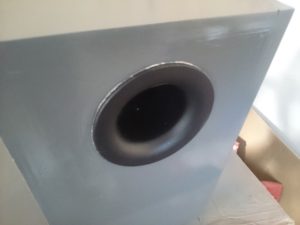First time trying to spray paint plywood…This weekend was warm, sunny and dry, so this was a good time to make some progress on the modular Voxel build, since the next task up was spray painting.
I had to get the Voxel cabinet done and two pieces of plywood that I wanted to use as the sides for the plate amplifier enclosure.
Preparation/Masking
If you look closely at pictures I from my previous posts, you’ll see that I put masking tape on the inside of the front baffle of the Voxel enclosure before I glued it in place. This was to prevent spray paint from getting into the inside of the enclosure through the cutout for the driver. — Not that it would have mattered much tho…
One peculiar point about the design of the Voxel is that you have to install the port tube before gluing on the front baffle: I would say it is pretty much impossible to get the inner piece of the port tube in place after the baffle is in place. And gluing the outer piece onto the inner piece with the front baffle in place seemed equally impractical.
This leaves you with the problem of how to prevent spray paint from getting onto the outer flare of the port tube. While the obvious answer is masking tape, the question is how does one apply masking tape to the narrow rim of the port tube so that one gets a clean paint line.
Her is what I came up with:
I put masking tape over the flare and tried to get it to stick as close to the rim as possible. At this step I was OK with covering part of the cabinet:
Next, I took a utility blade and traced the edge of the port tube, cutting the masking tape. Finally, I removed the part of the masking tape that ended up sticking to the plywood after cutting. Here is what I got in the end:
I have to say that this technique was only partially successful. Since the tape overlaps in certain parts I didn’t get a very clean paint line, but I would say it turned out good enough given that you usually don’t sit down with your face six inches away from the woofer port tube…
I also tried wrapping the masking tape around the rim, so that you effectively get a cylinder but that didn’t work well for me either, since the rim is not very high.
Spray Painting
I started out with spray-on primer as usual. The plan was to do two coats within a few minutes. However, the Voxel enclosure slid off the painter spikes after I put on the first coat and while I caught the cabinet before any damage was done, me catching it messed up the primer. So I had to set the enclosure aside, waiting for the primer to dry a little and then sanded the problem area. It took two more primer coats for things to get back to normal on the cabinet, but here is what I eventually ended up with after priming:
Since the weather was nice and warm I could keep the garage door and the back door open and since the instructions on the primer can said “recoat/topcoat any time” I waited for about an hour until the primer was dry to the touch and then applied two coats of spray paint.
And here is what I got:
While the paint was still not completely dry I took a pair of needle-nose pliers and carefully removed the masking tape from the port tube. I tried to do that whlie the paint was still wet. At least with latex paint I’ve learnt through painful experience that waiting until paint is completely dry before removing masking tape is a bad idea: You end up tearing the paint and don’t get a clean line.
As you can see in the picture below, the paint line around the port tube is not very clean. Also, you can still see the edge of the plywood:
However, the plywood edge looked better after the paint was completely dry and I was thinking about ways to touch up the paint job around the port flare, but at the end didn’t do it. Because everything looks fine unless you get closer than maybe a foot. And you usually don’t get that close to a shoe-box sized thing sitting in the corner of your living room.
Observations/Material Use with Primer
What was interesting is again how much applying primer cuts down on the number of coats you need to get a smooth finish. Also you use less paint. Doing all of the Quarks, the Voxel and the sides of the plate amplifier enclosure I ended up using about 1 2/3 cans of primer, but less than one can of actual spray paint.
Also priming seems to make spray painting a one-day affair: Put on primer, wait an hour for the primer to dry, then put on a coat of spray paint. After the first coat you will still see some banding, so apply a second coat right after the first. At this point the paint is even with a nice sheen, so I didn’t see a point in putting on another layer.
Also spray-painting plywood is not that different from spray painting MDF. Both have issues with edges and I think in both cases sealing might help. Also, if the light hits it just right and you look closely you can still see traces of the wood grain on plywood surfaces. Not sure if maybe sealing it with polyurethane and sanding before priming would have done something, but I don’ t think it is worth the effort and don’t mind.
While the paint was drying for a couple of hours, I went ahead and worked on the grilles for the Voxel cabinet and the plate amplifier enclosure.
More about that in the next post…




